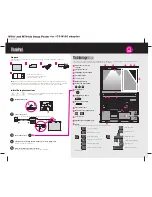
91
Chapter 6 Building your union
A union catalog can mean something very different from one district to the next.
While one district might process and distribute all records from a central location,
the next may rely on catalogers at each member site. No matter what your
situation, this version of Follett's Union Catalog Plus with or without Follett
Data Exchange Server is the most flexible district solution ever. The instructions
in this chapter assume that you have already decided on the type of union
catalog your district needs.
Who should read this?
Building a union catalog is a cooperative effort. No matter what type of union
catalog you're setting up, you'll need to be familiar with the members in your
district. For sites that won't be using Data Exchange (DX, for short), you'll need a
general idea of the quality of each member's MARC records so you can import
the highest quality records first. Setting up DX members not only requires
knowledge of your members' cataloging practices you'll also need to know
their participation preferences. DX members also require some additional, rather
technical, setup tasks, which are explained in the
Follett Data Exchange Guide
(fscdx.pdf).
Important:
We strongly recommend that you enlist the aid of your technology
coordinator or arrange to have Follett Software Company help you set
up the Follett Data Exchange Server.
Where do we begin?
To help you build your union catalog, we have included the following checklist
to guide you through the process:
Steps for building your union catalog
1. Before you begin, make sure you have all the information you'll need:
If you'll be doing original cataloging at the union catalog, you'll want a list of the
nonDewey call number prefixes used in your district.
If you'll be setting up any nonDX members, make sure you have the current setup
information for each, including the barcode symbology they use for library materials
and any circulation types or categories they use. If you haven't already, this would
also be a good time to request that they export their collections (MARC 21/852 hold
ings format) and send you the files for import. See page 112 for more information.
If you'll be setting up any DX members, make certain each has installed and set up
Circulation Plus/Catalog Plus. The Union Catalog Plus, Follett Data Exchange Server,
and member applications must all be the same version for a new union/DX
installation (currently, v5.0). Determine each member's level of participation (see page
93), and any material types, categories, call number prefixes, or circulation types the
member wants to exclude from the union catalog database (see page 94).
Important:
It is critical that
all
sites (member and union catalog, DX or not) have a full and
short version of their site name and a unique MARC Organization Code.
Summary of Contents for VERSION 6.00
Page 8: ...8 04 04 Notes...
Page 60: ...04 04 60 System Setup Notes...
Page 68: ...04 04 68 System Setup Notes...
Page 114: ...04 04 114 System Setup Notes...
Page 146: ...04 04 146 Circulation Desk Notes...
Page 216: ...04 04 216 Inventory Notes...
Page 254: ...04 04 254 Cataloging Notes...
Page 322: ...04 04 322 Cataloging Notes...
Page 370: ...04 04 370 Cataloging Notes...
Page 394: ...04 04 394 Alliance Plus Notes...
Page 402: ...04 04 402 Alliance Plus Notes...
Page 430: ...04 04 430 Search Stations Notes...
Page 498: ...04 04 498 Reports Notes...
Page 590: ...04 04 590 Reports Notes...
Page 642: ...04 04 642 Appendices Notes...
Page 698: ...04 04 698 Appendices Notes...
Page 726: ...04 04 726 Index...
Page 728: ......
Page 729: ......
















































